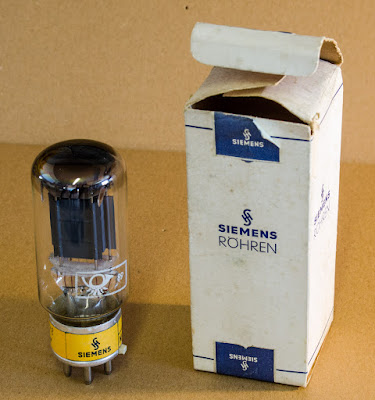In part 1 the story of these two preamplifier was already introduced. In this post I will reveal which tubes got tested and which were the favourites in terms of sound.
The test set up which was used for evaluation was already shown in part 1. An adjustable power supply provided all the necessary voltages for the different tubes.
Operating points are chosen with a couple of switches which selected from an array of resistors for cathode or filament bias.
Pretty much all directly heated triodes with an UX4 base are usable, for example: UX201A, UX112A, 26, 30, 31, 45, 50, 183/483 and 71A. But even indirectly heated triodes like the 27, 37, 56 or 76 could be used with socket adaptor.
Also the 46 was tested with a socket adaptor which tied grid 2 to the plate.
And in addition two european DHTs. A Siemens Da:
Again to be plugged in via an adaptor:
And the Telefunken RE074:
Also with an adaptor:
The 10Y or 801A were not included since I have separate preamps with these tubes which could be used for comparison. Hopes were very high for the european tubes and also the 45 and 50. But surprisingly none of them turned out to excel in this set up. To be fair, none of the tubes sounded really bad and the differences are rather subtle. After all the overall sound is largely determined by the circuit topology and its execution. One of the winners was not much of a surprise since I was already familiar with it:
The 26 which I already used in a 26 line stage before. It has a very gentle and smooth sound and applies a touch of 'dark chocolate' or 'caramel' flavour to the sound which can be very pleasing. This description is of course an exaggeration for illustration. The effect is rather subtle. The other tube which came out as a favourite and turned out to be even better than the 26 was the 31. A directly heated battery triode.
Shown above as UX231 in tubular shape. The 31 offered a very refined and high resolution sound in this set up. A runner ups in this competition were the 71A and 183/483 which also provided a very clean and impressive sound. Also not bad was the 27. It does not exhibit it the certain magic of indirectly heated triode but is very interesting nonetheless. More about this in an upcoming post.
Since the originator of the project could note decide between the 26 and 31, he commissioned two preamps.
Since both tubes run at similar plate voltages, the two preamps can be used with the same power supply. Both tubes run in filament bias. Additional bypass resistors are used in the 31 unit so it can work with the same power supply as the 26 without any switches.
The powert supply uses a full ave bridge with 4 half wave tube rectifiers. But not with 6AX4 TV dampers as usual but this time with a different tube, the 1V. More about this tube in an upcoming post.
Shown above both preamps with the PSU. The back sides:
An interesting project which gave some valuable insights. Thanks again to the originator of this. It has been an interesting journey. I'll ask for some sound descriptions from the owner of these preamps for another part of this story. Stay tuned!
Best regards
Thomas

















Happy New Year Thomas! Very excited to read this post.
ReplyDeleteAny issues with the 31and Miller effect In filament bias? Bias resistor is up there around 200 ohm give or take? Also curious about the transformers you used. Did you get away with a 1:1 with the 31 and 71A?
All the best for 2016! Jason
Hi Jason,
ReplyDeleteWhy would you see an issue with miller effect. The tube has a low amplification factor, miller effect is not really any problem. 200 Ohm would be a too high value for unbiassed cathode resistor, so i used a different trick. I also never use 1:1 transformers in line stages
Best regards
Thomas
I really love all of your work. I have to figure out how to buy a pre-amp of yours one day. How did the 201A fair? What amps was the preamp driving in this scenario? Was slew rate even an issue? I only ask because I am intrigued with the circuit, but have had slew rate issues in the past when working with some lower powered DHTs. Finally, how was the 31 in comparison to a 10Y? I must say the 10Y really does intrigue me the most (though I cannot say why).
ReplyDeleteHi!
DeleteYou can simply send an email for discussions about preamps to buy. There will be a part 3 which will be more about the sound and also with impressions from the owner of these preamps. See my posts about the 201A sound processor. The sound described there was also heard in this set up. But don't be too focussed on the tube sound. It is the remainder of the circuit which contributes most to the sound. The different tubes are just like a bit of seasoning. Sound impressions found in this set up don't necessarily translate to similar sounds of the tubes in other preamps
Hi Thomas,
ReplyDeleteGreat work again... From what I understand, you eschew any form of active regulation on the filaments (although not sure on B+ with gas tubes) But if ever a client requests for custom work with current regs for the filaments like the Coleman Regs, would you ever consider it? Or does it go too much against your design aesthetic and tastes? Thanks...
Hi!
DeleteSo far passive solutions had an edge over regulation. That's why I stick to it. If somebody requests regulated filament supplies, I will do that of course. I am not fanatic about this
Thomas